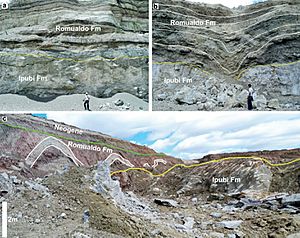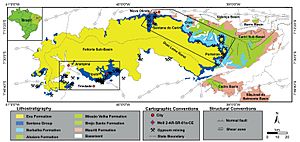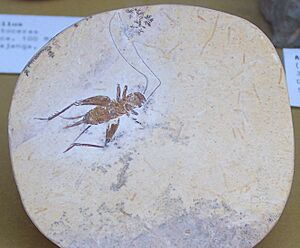Santana Formation facts for kids
Quick facts for kids Santana GroupStratigraphic range: Aptian-Albian ~115–108Ma |
|
|---|---|

Outcrop of the Santana Group; Ipubi & Romualdo Formations
|
|
| Type | Group |
| Sub-units | Romualdo, Ipubi & Crato Formations |
| Underlies | Araripina & Exu Formations |
| Overlies | Barbalha Formation |
| Lithology | |
| Primary | Mudstone, sandstone, shale, anhydrite |
| Other | Limestone, marl, siltstone |
| Location | |
| Coordinates | 5°36′S 64°18′W / 5.6°S 64.3°W |
| Approximate paleocoordinates | 9°12′S 34°00′W / 9.2°S 34.0°W |
| Region | |
| Country | |
| Extent | Araripe Basin |
| Type section | |
| Named for | Santana do Cariri |
 Extent of the Santana Group in blue |
|
The Santana Group is an amazing place in Brazil where many old fossils are found. It is located in the Araripe Basin, in the northeastern part of Brazil. This area is known as a Lagerstätte, which means it's one of the best fossil sites in the world. Many fossils here are perfectly preserved.

The rocks here formed about 92 million years ago. This was during the Lower Cretaceous period. At that time, the area was a shallow inland sea.
Contents
Discovering Ancient Life
Scientists have found over 25 different kinds of fish fossils here. Many of these fish still have their stomach contents preserved! This helps paleontologists learn about what these ancient creatures ate. They can also study how different animals interacted in their ecosystem.
Besides fish, many other types of fossils have been found. These include pterosaurs (flying reptiles), other reptiles, amphibians, and invertebrates. There are also many insects and plants. Even dinosaurs have been discovered here. For example, a new type of maniraptor dinosaur was found in 1996.
How Fossils Were Preserved
The fossils in the Santana Group are special because even soft body parts were saved. This happened because limestone lumps formed around dead animals and plants. These lumps protected the remains from decaying.
To study these fossils, scientists use a clever method. They carefully dissolve the limestone using a mild acid. Then, they use a "transfer technique." This means they embed the fossil into a plastic resin, like polyester or epoxy. This process makes the fossils strong and easy to study.
Santana Group and Crato Formation
The Santana Group is very similar to the nearby Crato Formation. The Crato Formation is also a Lagerstätte. It formed about 10 million years before the Santana Group. Both areas show us what life was like in ancient Brazil.
Amazing Animals Found Here
Many interesting animals have been discovered in the Santana Group. These include different kinds of theropod dinosaurs. Some examples are spinosaurus-like dinosaurs such as Irritator. Also, maniraptors like Santanaraptor have been found.
Flying Reptiles and Sea Creatures
All the pterosaurs found here are pterodactyls. This is because the long-tailed pterosaurs died out before this time. Famous pterosaurs like Ornithocheirus and Tupuxuara lived here. The ancient inland sea also had turtles, such as Santanachelys.
Images for kids
-
Fossil feathers and Dastilbe fossil




